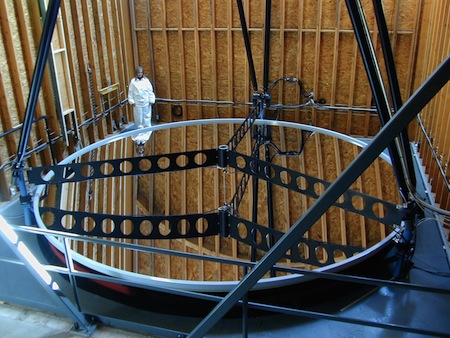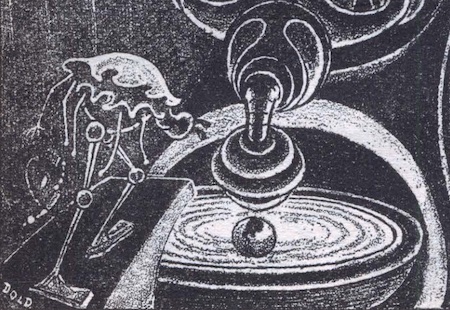Science Fiction
Dictionary
A B C D E F G H I J K L M N O P Q R S T U V W X Y Z
Telescopes With Liquid Mirrors Go Mainstream

Liquid mirror telescopes have been in limited use for two decades, but only now are they finally seeing the beginnings of wider acceptance in the astronomical community.

(The Large Zenith Telescope's 6-meter liquid mercury mirror)
The largest, the 6-meter Large Zenith Telescope (LZT) operated by the University of British Columbia in Vancouver, stands on a hilltop in a research forest some 40 miles east of the city.“At the LZT, our ability to do astronomy is limited by weather and sky conditions,” said Paul Hickson, an astronomer at the University of British Columbia in Vancouver, and the LZT’s project director.
As a result, the project focuses on atmospheric measurements that support advanced optics testing on planned conventional world-class, ground-based telescopes.
Unlike large glass mirrors which are subject to the vagaries of humidity, thermal dynamics and constant deformation from gravity itself, liquid mercury — which remains molten at room temperature — can reflect as much as 75 percent of incoming starlight with little of the fuss associated with large conventional mirrors.
However, liquid mirrors must rotate. When rotating, the forces of nature keep the thin layer of liquid mercury in the shape of a parabola. That’s the shape needed for the liquid mirror to be able to collect and focus incoming starlight.
And the rotation has to be both continuous and at a constant speed, which for the LZT is 8.5 revolutions per minute. If the mirror stops rotating for even a fraction of a second, it loses its parabolic shape, says Ermanno Borra, an astrophysicist at Quebec’s Laval University and a longtime advocate for liquid mirror technology.
Although Isaac Newton was the first to note that the free surface of a rotating liquid forms a curve that could be used to concentrate light for a telescope, science fiction writers brought it to readers' attention over the years. During the Golden Age of science fiction, Raymond Z. Gallun describes a liquid mirror telescope on Mars in his 1934 story Old Faithful.
Enigmatic forms of weird apparatus crowded in bewildering complexity against the walls. Tipped at a steep angle at the center of the floor was a vast cylinder of webby girders. Piercing the dome, opposite the upper end of the cylinder, was a circular opening through which a portion of the starlit sky was visible; and at the base of the cylinder a great bowl rotated rapidly, like a huge wheel.
(Mercury Telescope from 'Old Faithful' by Raymond Z. Gallun)
Via Forbes; thanks to Winchell Chung of Project Rho for the tip on this story.
Scroll down for more stories in the same category. (Story submitted 1/21/2013)
Follow this kind of news @Technovelgy.| Email | RSS | Blog It | Stumble | del.icio.us | Digg | Reddit |
Would
you like to contribute a story tip?
It's easy:
Get the URL of the story, and the related sf author, and add
it here.
Comment/Join discussion ( 0 )
Related News Stories - (" Engineering ")
Roborock Saros Z70 Is A Robot Vacuum With An Arm
'Anything larger than a BB shot it picked up and placed in a tray...' - Robert Heinlein, 1956.
Secret Kill Switch Found In Yutong Buses
'The car faltered as the external command came to brake...' - Keith Laumer, 1965.
The Desert Ship Sailed In Imagination
'Across the ancient sea floor a dozen tall, blue-sailed Martian sand ships floated, like blue smoke.' - Ray Bradbury, 1950.
The Zapata Air Scooter Would Be Great In A Science Fiction Story
'Betty's slapdash style.'
Technovelgy (that's tech-novel-gee!) is devoted to the creative science inventions and ideas of sf authors. Look for the Invention Category that interests you, the Glossary, the Invention Timeline, or see what's New.
Science Fiction
Timeline
1600-1899
1900-1939
1940's 1950's
1960's 1970's
1980's 1990's
2000's 2010's
Current News
Golf Ball Test Robot Wears Them Out
"The robot solemnly hit a ball against the wall, picked it up and teed it, hit it again, over and again...'
Boring Company Vegas Loop Like Asimov Said
'There was a wall ahead... It was riddled with holes that were the mouths of tunnels.'
Rigid Metallic Clothing From Science Fiction To You
'...support the interior human structure against Jupiter’s pull.'
Is The Seattle Ultrasonics C-200 A Heinlein Vibroblade?
'It ain't a vibroblade. It's steel. Messy.'
Roborock Saros Z70 Is A Robot Vacuum With An Arm
'Anything larger than a BB shot it picked up and placed in a tray...'
A Beautiful Visualization Of Compact Food
'The German chemists have discovered how to supply the needed elements in compact, undiluted form...'
Bone-Building Drug Evenity Approved
'Compounds devised by the biochemists for the rapid building of bone...'
Secret Kill Switch Found In Yutong Buses
'The car faltered as the external command came to brake...'
Inmotion Electric Unicycle In Combat
'It is about the size and shape of a kitchen stool, gyro-stabilized...'
Grok Scores Best In Psychological Tests
'Try to find out how he ticks...'
PaXini Supersensitive Robot Fingers
'My fingers are not that sensitive...'
Congress Considers Automatic Emergency Braking, One Hundred Years Too Late
'The greatest problem of all was the elimination of the human element of braking together with its inevitable time lag.'
The Desert Ship Sailed In Imagination
'Across the ancient sea floor a dozen tall, blue-sailed Martian sand ships floated, like blue smoke.'
The Zapata Air Scooter Would Be Great In A Science Fiction Story
'Betty's slapdash style.'
Thermostabilized Wet Meat Product (NASA Prototype)
There are no orbiting Michelin stars. Yet.
Could Crystal Batteries Generate Power For Centuries?
'Power could be compressed thus into an inch-square cube of what looked like blue-white ice'

